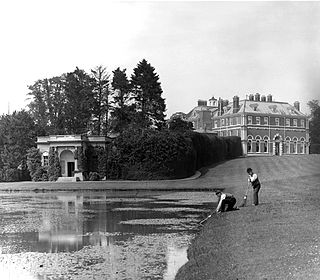Top Qs
Timeline
Chat
Perspective
Edward Levy-Lawson, 1st Baron Burnham
British newspaper proprietor (1833-1916) From Wikipedia, the free encyclopedia
Remove ads
Edward Levy-Lawson, 1st Baron Burnham, KCVO (28 December 1833 – 9 January 1916), known as Sir Edward Levy-Lawson, 1st Baronet, from 1892 to 1903, was an English newspaper proprietor. He was the owner and publisher of The Daily Telegraph.

Remove ads
Biography
Edward Levy-Lawson was born Edward Levy, in London, on 28 December 1833, the son of Joseph Moses Levy and his wife Esther (née Cohen). In December 1875 his name was legally changed to Levy-Lawson. He was educated at University College School in Hampstead, London. His father had acquired The Daily Telegraph – known as The Daily Telegraph and Courier – in 1855, only months after its founding. Levy-Lawson was editor and in control of the paper long before his father's death in 1888. From 1885, he was managing proprietor, and sole controller of his renamed The Daily Telegraph and became even more influential than his father on Fleet Street.
In 1875, he assumed by royal licence the surname of Lawson in addition to and after that of Levy. He bought the Hall Barn estate in 1880. He was created a Baronet, of Hall Barn in the County of Buckingham, in 1892, and in 1903 he was raised to the peerage as Baron Burnham, of Hall Barn in the Parish of Beaconsfield in the County of Buckingham. In 1886, he was appointed High Sheriff of Buckinghamshire.[1]
Remove ads
Personal life
Summarize
Perspective
Levy-Lawson's family was Jewish.[2] He married Harriette Georgiana Webster, daughter of Benjamin Nottingham Webster, at Parish Church, Kennington, Kent, in 1862. They had three children together, Harry (later Viscount Burnham), William and Edith. Lady Burnham died in 1897. It is also believed that Levy-Lawson may have been the natural father of the author Reginald Turner, although Turner's father may have been another man of the Levy-Lawson family.[3][4]
Lord Burnham's love of pheasant shooting resulted in him enjoying a close relationship with King Edward VII, his son, King George V, and his son King Edward VIII, with King George paying yearly visits to him at his home, the 4,000 acre estate Hall Barn.[5][6][7] On 18 December 1913, it was recorded by the Prince of Wales himself – later King Edward VIII – that he and his father King George had "shot over a thousand pheasants in six hours – about one bird every 20 seconds". Altogether, 3,937 pheasants were killed. While it has been said that the shoot was not a slaughter and that very respectable birds were presented to the Guns, on the train journey home, the Prince of Wales noticed that the King was unusually quiet, his silence eventually broken when he famously said: "Perhaps we overdid it today."[8][9][6][10][11]
Lord Burnham died on 9 January 1916, aged 82, in Forest Gate, London, and was succeeded in the barony by his eldest son Harry. He was buried in Beaconsfield, Buckinghamshire.[12]
Remove ads
Arms
|
Notes
References
External links
Wikiwand - on
Seamless Wikipedia browsing. On steroids.
Remove ads

